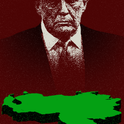For two weeks this summer, the centre of Paris was fought over by two very different visions of the future that completely ignored each other. (They also ignored the plans of its socialist mayor Anne Hidalgo to make Paris a greener and more equitable city—plans that have already turned much of it into a giant construction site.) In a ceremony at the end of June that involved wrapping the Pont Neuf in gold, the CEO of the LVMH (Moët Hennessy Louis Vuitton) luxury conglomerate, Bernard Arnault, presided over the coronation of Pharrell Williams as the world king of fashion (in other words, head of menswear at Louis Vuitton). Seven days later, the shooting of an unarmed teenager triggered riots that led to 3,600 arrests and serious damage to almost as many buildings, including a training facility being built for next year’s Olympics.
Fashionable Paris shrugged aside the riots as quickly as they had broken out. While the suburbs beyond the city’s ring road—where nine million of its 11m people live—were still burning, Marion Cotillard, Tilda Swinton and house muse Vanessa Paradis were in the audience for Chanel’s open-air catwalk. In coverage worthy of Marie Antoinette, AFP reported: “The elegant Chanel woman stormed the banks of the Seine with her dog, a basket of flowers and chic nonchalance.” Claims that the rioters had looted a Louis Vuitton store in Paris were debunked when it turned out the YouTube footage had actually been filmed in the US during the Black Lives Matter protests.
Instead of Jill Biden and the crown prince of Japan, who watched King Charles III being crowned, Williams’s 1,750-strong congregation had Beyoncé, Rihanna and A$AP Rocky as guests. Instead of the choristers at the Abbey, Williams had golf carts driven by models towing LVMH luggage. He opened with a recital by 50-person orchestra accompanying Lang Lang on the piano. He brought on a gospel choir of 80 singers and ended with Jay-Z in concert. After the performance, Williams fed the masses with champagne and burgers wrapped in LVMH monogrammed paper napkins.
In creating a convincing ceremony that looked at least superficially inclusive, Arnault had achieved everything for Paris that Charles failed to do in Westminster Abbey.
A new imperial tradition had been created. Arnault is also responsible for the transformation of the La Samaritaine, an art nouveau department store overlooking the Pont Neuf, into a contemporary temple of consumerism. He has positioned a giant representation of the Japanese artist Yayoi Kusama outside the store. Kusama stands 15 metres high, holding a Louis Vuitton bag in one hand and a brush in the other with which she is flicking paint at Arnault’s office across the street. The splashes stick to the length of the 19th-century stone facade like pastel-coloured cowpats. They are the same dots that decorate the company’s leather handbags.
Across the river, Arnault paid for Williams’s 30-metre-tall billboard featuring a pregnant Rihanna photographed with the LVMH logo, to be installed on the full height of the main facade of the Musée d’Orsay ahead of his first runway show.
London, which had its own pre-Olympic riots in 2011 when the Metropolitan Police shot and killed Mark Duggan in Tottenham, has been engaged in a centuries-old back-and-forth, tit-for-tat struggle with Paris to be regarded as the uncontested capital city of Europe. London inspired Napoleon III to commission Baron Haussmann to remodel Paris on lines even grander than John Nash’s reimagining of Regent Street and Regent’s Park, Buckingham Palace and the Mall that the emperor had seen as an exile in England.
London built the first metro system, but it took 50 years to catch up with Paris’s RER by building the Elizabeth Line. Despite Boris Johnson shamelessly claiming credit for Ken Livingstone’s plan for a civic bike hire scheme in London, it was only after Paris had popularised the idea.
The generous spaces of the Elizabeth Line make the RER look scruffy, but the Grand Paris express will finally deal with the long neglected outer suburbs. When it is completed in 2030, its 68 new stations will serve two million passengers every day with a huge 200-kilometre loop line circling the capital, at a distance as far from Nôtre Dame as Barking is from Westminster Abbey.
Reasserting its traditional hold on fashion is only one aspect of the massive transformation that Paris is going through. In the seven years since Britain voted to leave the European Union, Paris’s banking sector has really begun to threaten London, gaining at least 5,000 financial services jobs.
There has been a significant shift to Paris in the cultural sector too.
The contemporary art galleries that came to London 20 years ago have set up additional outposts in Paris. Gagosian, which now has three spaces in Paris, and David Zwirner were the first to open. The White Cube followed, and Hauser & Wirth will open an 800-square-metre gallery in a neoclassical hôtel particulier close to the Champs Elysées this October. Paris has also gained the global art auction sale market share from London.
Paris has a unique cluster of private cultural institutions that London can’t match. The Frank Gehry-designed Fondation Louis Vuitton was followed two years ago by François Pinault’s collection at the Bourse de Commerce. Chris Dercon, former director of the Tate Modern, is overseeing the transformation of a whole block on the Rue de Rivoli between the Louvre and the Palais Royal into a new gallery on the scale of the Turbine Hall for the Cartier Foundation.
To visitors from London, watching jobs and power slip away from their own capital, the mystery is that many Parisians don’t see it the same way. A substantial and noisy minority believe that their city is dirtier, poorer and more dangerous than it has ever been.
In November last year, Emmanuel Macron’s then-public accounts minister, Gabriel Attal, described Hildalgo’s ballooning budget deficit as a gigantic Ponzi scheme after she had pushed up property taxes by 7 per cent to bolster the city’s finances. One of Anne Hidalgo’s well-organised opponents call the socialist mayor of Paris since 2014 a “narcissist megalomaniac”. Sceptics might suggest these are essential parts of the job description for any directly elected mayor. Jacques Chirac, first mayor of Paris in a century, fired the architect of the Les Halles shopping centre, appointed by the French president of the day, Giscard d’Estaing. “L’architecte en chef des Halles, c’est moi,” he declared as soon as he came to power.
But the hashtag #saccageparis campaign portrays Hidalgo as a politician who is bent on laying waste to the city.
Her critics hate the big things that she is pushing through—such as the 180-metre-high Tour Triangle, the first skyscraper in the city for 40 years. And they hate the little things too, like the Mikado benches, crude blocks of timber that took the place of the delicate, cast-iron neoclassical benches that characterised the city as much as Haussmann’s boulevards. They hate the new plan for landscaping around the soon-to-be-complete rebuilding of Nôtre Dame. They hate the closure to car traffic of the Rue de Rivoli. And they hate the mayor’s plan, now getting underway to turn the Place de la Concorde into a garden and remodel the Champs Elysées with climate-change-resistant trees.
There are cities with worse things to worry about than Paris. While Parisians have agitated about street furniture, in San Francisco (which has conspicuously failed to recover from the effects of the Covid pandemic) the mayor, London Breed, is struggling to deal with the threat of the city turning into California’s version of Detroit. The Mission District in the city centre is a shanty town of street sleepers. Westfield abandoned the city’s largest central mall in June and nearly one-third of its office space is empty.
Hidalgo is tackling things that Britain, with its sewage-filled rivers, would welcome. Some 35,000 homes in Greater Paris that previously drained straight into the Seine are being connected to the sewers.
She has committed to reducing the energy consumption of the city’s own buildings. All diesel cars will be banned from Paris next year and, from 2030, only electric and hydrogen-cell cars will be able to enter the city.
But the right has become more strident in its opposition to green urban policies everywhere. Ada Colau, Hidalgo’s counterpart in Barcelona, lost her job as mayor in June after eight years having pursued a range of policies that included curtailing Airbnb, closing large areas of the city to traffic and planting more trees. In London, though Sadiq Kahn succeeded in extending the ultra-low emission zone to the outer boroughs, it was at the cost of a Labour victory in the Uxbridge byelection. It also emboldened the idiocy of David Frost and his suggestion that more Britons die of cold than global warming.
Hidalgo is no pushover. She took Airbnb to court and won an €8m-euro settlement for breaking the city’s rental rules. She saw off a derisory offer from Paris St Germain’s owners to buy the Parc des Princes stadium from the city.
Paris’s ability to maintain its edge over London will depend on Hidalgo’s delivery of her promises. It is true that the banks of the Seine themselves are traffic-free now but major roads, thick with cars, still run along both sides of the river, lined with litter bins overflowing with wine and beer bottles, cans and Styrofoam food containers.
The Place de la Concorde is no longer a Circus Maximus of whirling traffic, but it is still very much a work in progress. Drivers trying to negotiate its northern edge from the Rue de Rivoli toward the Champs Elysées are confronted with an impassable wall of tourist buses blocking their path that has them howling with frustration.
And the Rue de Rivoli itself, where I found no fewer street sleepers than I encounter in my part of London, is still an uneasy no man’s land that pedestrians are reluctant to claim from the single lane of car traffic.
If Hidalgo succeeds, Paris will be as much a model for the 21st-century city as it was in the 19th. If she doesn’t, the centre of Paris will become a larger version of Venice, without the canals: left to the tourists dragging their suitcases and eating their sandwiches on the steps of the Louvre, traffic-free but losing population fast to the suburbs—and ruled over in imperial style by Bernard Arnault and Pharrell Williams.












